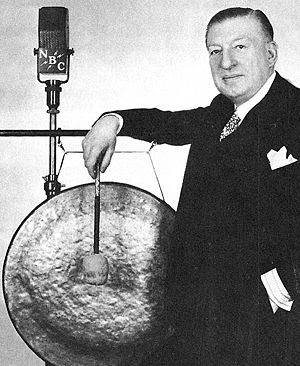Edward Bowes (Edward Bowes)

Edward Bowes’ father died when he was six years old, and young Bowes worked as he could to augment the family income. After leaving grammar school he worked as an office boy and then went into the real estate business, until the cataclysmic 1906 San Francisco earthquake wiped out his fortune. He then went to New York City in search of other opportunities. He soon realized that the theatrical world was lucrative, and he worked busily in New York as a musical conductor, composer, and arranger. He also produced Broadway shows, such as Kindling in 1911–12 and The Bridal Path in 1913. He was married to Kindling star Margaret Illington, from 1910 until her death in 1934; her portrait by Adolfo Müller-Ury had been painted in 1906 for her first husband, the theatre manager, Daniel Frohman. Edward Bowes became managing director of New York’s imposing Capitol Theatre, which he ran with military efficiency and bearing. He insisted on being addressed as “Major Bowes”. His nickname sprang from his earlier military rank, though historians are divided on whether he was an active-duty officer in World War I or held the rank as a member of the Officer Reserve Corps. Bowes brought his best-known creation to New York radio station WHN in 1934. He had actually hosted scattered amateur nights on smaller stations while manager of the Capitol. Within a year of its WHN premiere, The Original Amateur Hour —its original name, according to historian Gerald Nachman, was Major Bowes and His Capitol Family — began earning its creator and host as much as $1 million a year, according to Variety.
The rapid popularity of The Original Amateur Hour made him better known than most of the talent he featured. Some of his discoveries did become stars, including opera stars Lily Pons, Robert Merrill, and Beverly Sills; comedian Jack Carter; pop singer Teresa Brewer; and, Frank Sinatra, fronting a quartet known as the Hoboken Four when they appeared on the show in 1935. The show consistently ranked among radio’s top ten programs throughout its entire run. Bowes’s familiar catchphrase, “… around and around she goes and where she stops nobody knows.” spoken in the familiar avuncular tones for which he was so renowned, whenever it was time to spin its “wheel of fortune”, the device by which some contestants were called to perform. In the early days of the show, whenever a performer was simply too terrible to continue, Edward Bowes would stop the act by striking a gong (a device that would be revived in the 1970s by Chuck Barris’s infamous The Gong Show). Bowes heard from thousands of listeners who objected to his terminating these acts prematurely, so he abandoned the gong in 1936. Nachman recorded that Bowes, “a businesslike fellow with a mirthless chuckle who, unlike most emcees, had a gift for nongab”, went out of his way to make contestants feel at ease, habitually taking them out to dinner before their appearances. Nachman credits Bowes for featuring more black entertainers than many network shows of the time. Edward Bowes died on the eve of his 72nd birthday at his home in the New Jersey suburb of Rumson, New Jersey.
Born
- June, 14, 1874
- USA
- San Francisco, California
Died
- June, 13, 1946
- USA
- Rumson, New Jersey
Cemetery
- Sleepy Hollow Cemetery
- Sleepy Hollow, New York
- USA



